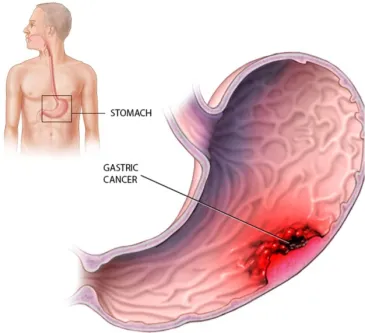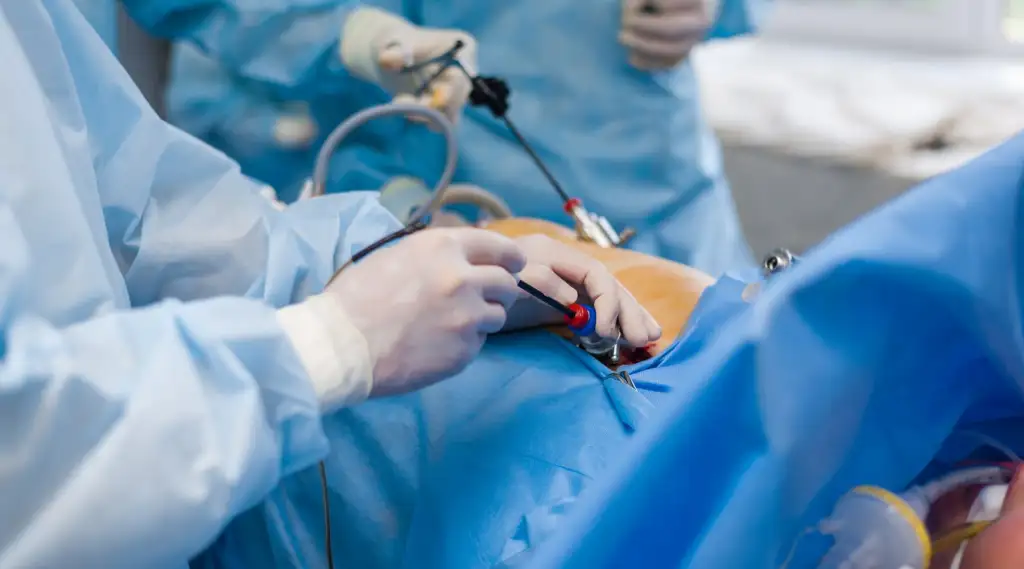Stomach Cancer
Dr. Nikhil Shellagi
MS Surgery, DNB Surgical Gastroenterology Fellowship in HPB and Liver Transplantation

Best Stomach Cancer Treatment in Bangalore
Stomach Cancer Treatment
Stomach cancer is also known as gastric cancer. It is a buildup of abnormal cells that form a mass in part of the stomach. Stomach cancer usually begins in the mucus-producing cells that line the stomach.
Parts of the stomach
Cardia: The first part is closest to the esophagus
Fundus: The upper part of the stomach next to the cardia
Body (corpus): The main part of the stomach, between the upper and lower parts
Antrum: The lower portion (near the intestine), where the food mixes with gastric juice
Pylorus: The last part of the stomach, which acts as a valve to control the emptying of the stomach contents into the small intestine.


Adenocarcinoma: Most (about 90% to 95%) cancers of the stomach are adenocarcinomas. Stomach cancer or gastric cancer almost always is an adenocarcinoma. These cancers develop from the cells that form the innermost lining of the stomach (the mucosa).
Lymphoma: These are cancers of the immune system tissue that are sometimes found in the wall of the stomach. The treatment and outlook depend on the type of lymphoma.
Gastrointestinal stromal tumor (GIST): These rare tumors start in very early forms of cells in the wall of the stomach called interstitial cells of Cajal. Some of these tumors are non-cancerous (benign); others are cancerous. Although GISTs can be found anywhere in the digestive tract, most are found in the stomach.
Carcinoid tumor: These tumors start in hormone-making cells of the stomach. Most of these tumors do not spread to other organs.
Other types of cancer, such as squamous cell carcinoma, small cell carcinoma, and leiomyosarcoma, can also start in the stomach, but these cancers are very rare.
- Fatigue
- Feeling bloated after eating
- Feeling full after eating small amounts of food
- Severe, persistent heartburn
- Severe indigestion that is always present
- Unexplained, persistent nausea
- Stomach pain
- Persistent vomiting
- Unintentional weight loss
If you have signs and symptoms that worry you, make an appointment with your doctor. Your doctor will likely investigate more common causes of these signs and symptoms first.
Diagnosis of Acute hepatitis involves:
- a complete medical history and medical examination
- Blood tests especially Liver function tests, PT-INR, coagulation profile
- Specific laboratory tests for virus detection
- Ultrasonography as an imaging tool
Treatment of Acute Hepatitis
Treatment for acute hepatitis depends on the condition of patient. The patients may need admission to a hospital in the initial phase for complete evaluation and st
- A tiny camera to see inside your stomach (upper endoscopy): A thin tube containing a tiny camera is passed down your throat and into your stomach. Your doctor can look for signs of cancer. If any suspicious areas are found, a piece of tissue can be collected for analysis (biopsy).
- Imaging tests: Imaging tests used to look for stomach cancer include computerized tomography (CT) scans and a special type of X-ray exam sometimes called a barium swallow.
- Determining the extent (stage) of stomach cancer
The stage of your stomach cancer helps your doctor decide which treatments may be best for you. Tests and procedures used to determine the stage of cancer include:
- Imaging tests: Tests may include CT and positron emission tomography (PET).
- Exploratory surgery: Your doctor may recommend surgery to look for signs that your cancer has spread beyond your esophagus or stomach, within your chest or abdomen. Exploratory surgery is usually done laparoscopically. This means the surgeon makes several small incisions in your abdomen and inserts a special camera that transmits images to a monitor in the operating room.
abilization. Most patients need supportive medical care which is determined by the treating liver physician based on the individual patient and disease severity parameters.
Majority of the people recover uneventfully with just supportive care. Severe acute hepatitis may require ICU care and appropriate management as per the treating team.
Stage I: At this stage, the tumor is limited to the top layer of tissue that lines the inside of the esophagus or stomach. Cancer cells also may have spread to a limited number of nearby lymph nodes.
Stage II: Cancer at this stage has spread deeper, growing into a deeper muscle layer of the esophagus or stomach wall. Cancer may also have spread to more of the lymph nodes.
Stage III: At this stage, cancer may have grown through all the layers of the esophagus or stomach and spread to nearby structures. Or it may be a smaller cancer that has spread more extensively to the lymph nodes.
Stage IV: This stage indicates that cancer has spread to distant areas of the body.
In cancer care, different types of doctors often work together to create a patient’s overall treatment plan that combines different types of treatments. This is called a multidisciplinary team. For stomach cancer, this team may include the following doctors:
- Gastroenterologist: a doctor who specializes in the gastrointestinal tract including the stomach and intestines
- The surgeon or surgical oncologist: a doctor who specializes in treating cancer using surgery
- Medical oncologist: a doctor who specializes in treating cancer with medication
- Radiation oncologist: a doctor who specializes in giving radiation therapy to treat cancer
- Pathologist: a doctor who specializes in interpreting laboratory tests and evaluating cells, tissues, and organs to diagnose disease.
- Radiologist: a medical doctor who specializes in using imaging tests to diagnose disease

- Surgery is the removal of the tumor and some surrounding healthy tissue during an operation. The type of surgery used depends on the stage of cancer.
Radiation therapy
Radiation therapy is the use of high-energy x-rays or other particles to destroy cancer cells. A radiation therapy regimen, or schedule, usually consists of a specific number of treatments given over a set period of time. People with stomach cancer usually receive external-beam radiation therapy, which is radiation given from a machine outside the body. Radiation therapy may be used before surgery to shrink the size of the tumor or after surgery to destroy any remaining cancer cells.
Therapies using medication
Systemic therapy is the use of medication to destroy cancer cells. This type of medication is given through the bloodstream to reach cancer cells throughout the body.
Common ways to give systemic therapies include an intravenous (IV) tube placed into a vein using a needle or in a pill or capsule that is swallowed (orally).
The types of systemic therapies used for stomach cancer include:
- Chemotherapy
- Targeted therapy
- Immunotherapy
- Chemotherapy
Chemotherapy is the use of drugs to destroy cancer cells, usually by keeping the cancer cells from growing, dividing, and making more cells. - Targeted therapy
Targeted therapy is a treatment that targets cancer’s specific genes, proteins, or the tissue environment that contributes to cancer growth and survival. This type of treatment blocks the growth and spread of cancer cells while limiting damage to healthy cells. - Immunotherapy
Immunotherapy also called biologic therapy, is designed to boost the body’s natural defenses to fight cancer. It uses materials made either by the body or in a laboratory to improve, target, or restore immune system function.

